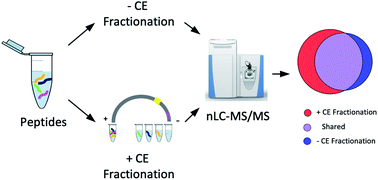Preparative capillary electrophoresis (CE) fractionation of protein digests improves protein and peptide identification in bottom-up proteomics†
Abstract
Reversed-phase liquid chromatography (RPLC) is widely used to reduce sample complexity prior to mass spectrometry (MS) analysis in bottom-up proteomics. Improving peptide separation in complex samples enables lower-abundance proteins to be identified. Multidimensional separations that combine orthogonal separation modes improve protein and peptide identifications over RPLC alone. Here we report a preparative capillary electrophoresis (CE) fractionation method that combines CE and RPLC separations. Using this method, we demonstrate improved protein and peptide identification in a tryptic digest of E. coli cell lysate, with 132 ± 33% more protein identifications and 185 ± 65% more peptide identifications over non-fractionated samples. Fractionation enables detection of lower-abundance proteins in this complex sample. We demonstrate improved coverage of ovarian cancer biomarker MUC16 isolated from conditioned cell media, with 6.73% sequence coverage using CE fractionation compared to 2.74% coverage without preparative fractionation. This new method will allow researchers performing bottom-up proteomics to harness the advantages of CE separations while using widely available LC-MS/MS instrumentation.



 Please wait while we load your content...
Please wait while we load your content...